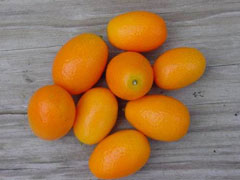


Home
Flowers &
Indoor Plants
Fruits & Nuts
Ornamentals
Vegetables
Special Topics
Resources
Glossary

|
Kumquat Fortunella margarita (for-toon-el-lah mar-gar-ee-tuh)   Click on thumbnails for larger image. |
 |
What about it? The kumquat is a fruit that many people associate with the winter holidays in this country, since it is most available around that time. In China it is an important crop, and it is consumed in much greater quantities there. This fruit is very similar to citrus crops in many ways, even thought it belongs to a different genus, but the flesh of the kumquat has more of a "bite," while the rind is edible and sweet. The kumquat is slightly more cold-hardy than some members of the citrus group, such as lemon. What is it used for? The kumquat is tasty fresh, and the whole fruit can be eaten, including the rind. It makes an interesting addition to fruit salads. It also is good in jam or marmalade. The tree is an attractive plant that southern gardeners use in containers or in espalier (which means to train along a lattice or trellis, or into interesting shapes). Where does it grow? How do we grow it? Kumquats are more cold resistant than are citrus trees, but they are still grown mainly in the South and West. Their culture is similar to that of citrus, but many southern and western gardeners choose to grow them in containers, and even to use them for bonsai. What are its primary problems? Kumquats are not plagued by any particular pests or diseases. How do we harvest and store it? Kumquats will take about 6 months to ripen. There are several varieties, including an oval 'Nagami' type and a round 'Marumi' kumquat. Sweeter fruits are produced under warm temperatures. The fruit can be eaten fresh out-of-hand or in salads. It can also be preserved or candied.
© Copyright, Department of Horticulture, Cornell University. |